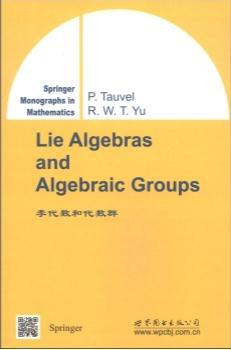李代数和代数群

内容简介:
《李代数和代数群》属于springer数学专著系列之一,秉承了这个系列的特点,经典,专业性强。本书分为40个小节,致力于李群和代数群理论的研究,包括大量的组合代数和代数几何知识,使得本书体系性更强。本书旨在将该理论的代数方面集中在一卷来讲述,展示了特征零中的理论基础。并 且囊括了详细证明,在最后一节中讨论了一些最近结果。 The theory of groups and Lie algebras is interesting for many reasons. In the mathematical viewpoint, it employs at the same time algebra, analysis and geometry. On the other hand, it intervenes in other areas of science, in particular in different branches of physic8 and chemistry. It is an active domain of current research. The general theory of algebraic groups is studied in chapter8 21 to 28. The relations between Lie algebras and algebraic groups, which are fundamental to us, are established in chapters 23 and 24. Chapter 29 present8 applications of these relations to tackle the systematic study of Lie algebras. The reader will observe that the geometrical aspects have an important part in this study.In particular, the orbits of points under the action of an algebraic group plays a central role.
目录:
1 Results on topological spaces 1.1 Irreducible sets and spaces 1.2 Dimension 1.3 Noetherian spaces 1.4 Constructible sets 1.5 Gluing topological spaces 2 Ring8 and modules 2.1 Ideals 2.2 Prime and maximal ideals 2.3 Rings of fractions and localization 2.4 Localizations of modules 2.5 Radical of an ideal 2.6 Local rings 2.7 Noetherian rings and modules 2.8 Derivations 2.9 Module of differentials 3 Integral extensions 3.1 Integral dependence 3.2 Integrally closed domains 3.3 Extensions of prime ideals 4 Factorial rings 4.1 Generalities 4.2 Unique factorization 4.3 Principal ideal domains and Euclidean domains 4.4 Polynomials and factorial rings 4.5 Symmetric polynomials 4.6 Resultant and discriminant 5 Field extensions 5.1 Extensions 5.2 Algebraic and transcendental elements 5.3 Algebraic extensions 5.4 Transcendence basis 5.5 Norm and trace 5.6 Theorem of the primitive element 5.7 Going Down Theorem 5.8 Fields and derivations 5.9 Conductor 6 Finitely generated algebras 6.1 Dimension 6.2 Noether's Normalization Theorem 6.3 Krull's Principal Ideal Theorem* 6.4 Maximal ideals 6.5 Zariski topology 7 Gradings and filtrations 7.1 Graded rings and graded modules 7.2 Graded submodules 7.3 Applications 7.4 Filtrations 7.5 Grading associated to a filtration 8 Inductive limits 8.1 Generalities 8.2 Inductive systems of maps 8.3 Inductive systems of magmas, groups and rings 8.4 An example 8.5 Inductive systems of algebras 9 Sheaves of functions 9.1 Sheaves 9.2 Morphisms 9.3 Sheaf associated to a presheaf 9.4 Gluing 9.5 Ringed space 10 Jordan decomposition and some basic results on groups 10.1 Jordan decomposition 10.2 Generalities on groups 10.3 Commutators 10.4 Solvable groups 10.5 Nilpotent groups …… 11 Algebraic sets 12 Prevarieties and varieties 13 Projective varieties 14 Dimension 15 Morphisms and dimension 16 Tangent 8paces 17 Normal varieties 18 Root systems 19 Lie algebras 20 Semisimple and reductive Lie algebras 21 Algebraic groups 22 Affine algebraic groups 23 Lie algebra of an algebraic group 24 Correspondence between groups and Lie algebras 25 Homogeneous space8 and quotients 38 Semisimple symmetric Lie algebras 39 Sheets of Lie algebras, 40 Index and linear forms References List of notations Index




评论